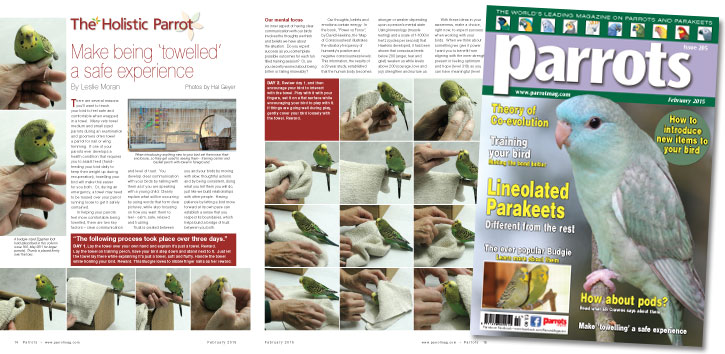
Make being ‘towelled’ a safe experience
By Leslie Moran
There are several reasons you’ll want to teach your bird to feel safe and comfortable when wrapped in a towel. Many vets towel medium and small sized parrots during an examination and groomers often towel a parrot for nail or wing trimming. If one of your parrots ever develops a health condition that requires you to assist feed (hand-feeding your bird daily to keep their weight up during recuperation), towelling your bird will make this easier for you both. Or, during an emergency, a towel may need to be tossed over your parrot running loose to get it safely contained.
In helping your parrots feel more comfortable being towelled, there are two key factors – clear communication and level of trust. You develop clear communication with your birds by talking with them as if you are speaking with a young child. Clearly explain what will be occurring by using words that form clear pictures, while also focusing on how you want them to
feel - calm, safe, relaxed and trusting.
Trust is created between you and your birds by moving with slow, thoughtful actions and by being consistent, doing what you tell them you will do, just like we build relationships with other people. Having patience by letting a bird move forward at its own pace can establish a sense that you respect its boundaries, which helps build a bridge of trust between you both.
Buy Now!
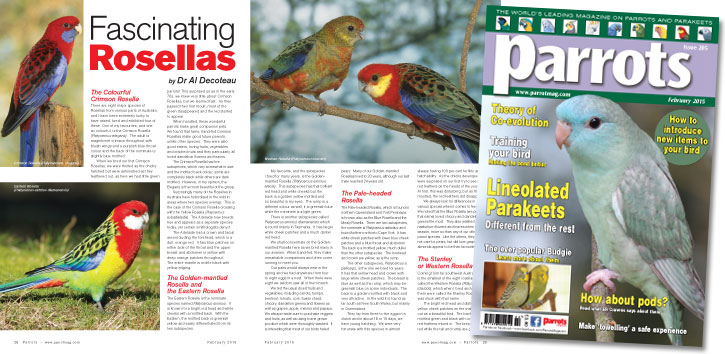
By Dr Al Decoteau
There are eight major species of Rosellas from various parts of Australia, and I have been extremely lucky to have raised, bred and exhibited four of these. One of my favourites, and one so colourful, is the Crimson Rosella (Platycercus elegans). The adult is magnificent crimson throughout with bluish wings and a purplish blue throat colour and the back of the nominate is slightly blue mottled.
When we bred our first Crimson Rosellas, we were thrilled as the chicks hatched but were astonished as they feathered out, as here we had little green parrots! This surprised us as in the early 70s, we knew very little about Crimson Rosellas, but we learned fast. As they passed their first moult, most of the green disappeared and the red started to appear.
Buy Now!
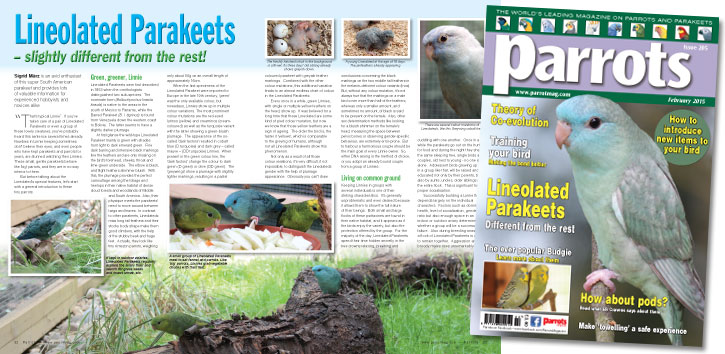
By Sigrid März
Sigrid März is an avid enthusiast of this super South American parakeet and provides lots of valuable information for experienced hobbyists and novices alike.
“That's typical Linnie˝. If you've taken care of a pair of Lineolated Parakeets or even a group of these lovely creatures, you've probably heard this sentence several times already. Newbies in Linnie keeping sometimes don't believe their eyes, and even people who have kept parakeets and parrots for years, are stunned watching their Linnies. These small, gentle parakeets behave like 'big' parrots, and they are in no way inferior to them.
But before talking about the Lineolated's special features, let's start with a general introduction to these
tiny parrots.
Buy Now!
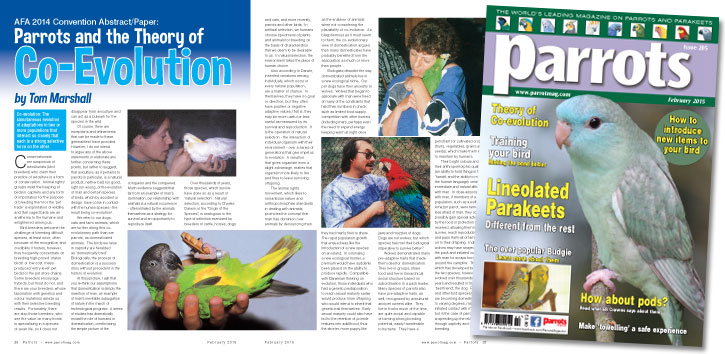
AFA 2014 Convention Abstract/Paper
By Tom Marshall
Co-evolution: The simultaneous evolution of adaptations in two or more populations that interact so closely that each is a strong selective force on the other.
Conservationists are suspicious of aviculturists (bird breeders) who claim their practice of aviculture is a form of conservation. Animal rights' groups insist the keeping of birds in captivity and any form of importation for the purpose of breeding them for the ‘pet trade’ is exploitation of wildlife, and that caged birds are an anathema to the humane and enlightened among us.
Bird breeders welcome the challenge of breeding difficult species, at least once, often because of the recognition and credibility it fosters, however, they frequently concentrate on breeding high-priced ‘status birds’ or low cost, mass-produced ‘entry-level’ pet birds for the pet store chains. Some breeders encourage hybrids, but most do not, and there are your breeders, whose fascination with genetics and colour mutations amaze us with their selective breeding results. Fortunately, there are also those breeders, who see the value on many fronts in specialising in a species of avian life, so it does not disappear from aviculture and can act as a bulwark for the species in the wild.
Buy Now!
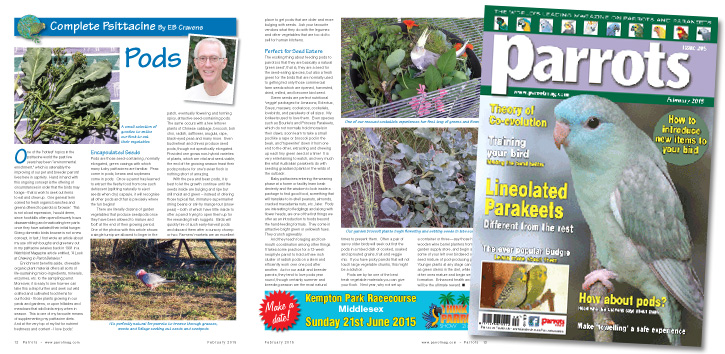
Pods
By Eb Cravens
One of the ‘hottest’ topics in the psittacine world the past few years has been “environmental enrichment,” which is ostensibly the improving of our pet and breeder parrots’ lives here in captivity. Hand in hand with this ongoing concept is the offering of circumstances in order that the birds may forage - that is work to seek out items to eat and chew up. One general term coined for fresh organic branches and greens offered to parrots is 'browse'. This is not a bad expression, I would deem, since hookbills often spend leisurely hours disassembling and masticating tree parts once they have satiated their initial hunger. Giving domestic birds browse is not a new concept, in fact, I first wrote an article about my use of fresh boughs and greenery out in my psittacine aviaries back in 1991 in a Watchbird Magazine article entitled, “A Look at Chewing in Parrot Behavior.”
Enrichment benefits aside, chewable organic plant material offers all sorts of life-sustaining micro-ingredients, minerals, enzymes, etc. to the sampling parrot. Moreover, it is easy to see how we can take this a step further and seek out wild crafted and cultivated food items for our flocks - those plants growing in our yards and gardens, or upon hillsides and meadows that wild birds enjoy when in season. This is one of my favourite means of supplementing my psittacine diets. And at the very top of my list for nutrient freshness and content - I love 'pods'.
Buy Now!





